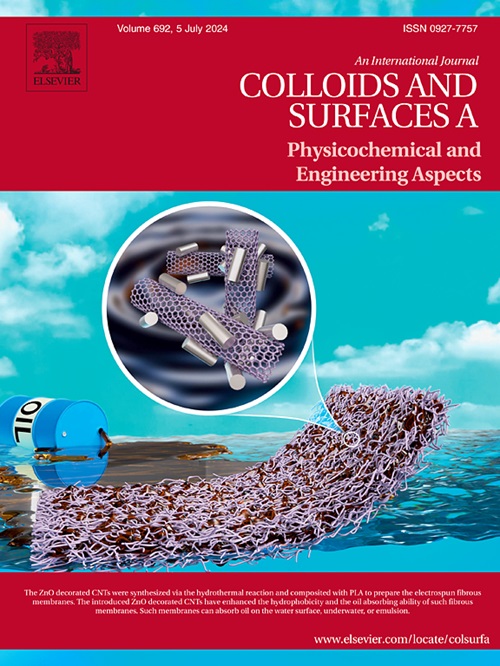Unraveling the synergistic effects of trapping and active sites on SO₂/H₂O-resistance of transition-metal modified Ce-TiO₂ dual-site catalysts via DFT calculation
IF 5.4
2区 化学
Q2 CHEMISTRY, PHYSICAL
Colloids and Surfaces A: Physicochemical and Engineering Aspects
Pub Date : 2025-07-17
DOI:10.1016/j.colsurfa.2025.137790
引用次数: 0
Abstract
Achieving SO2/H2O resistance in Ce-based catalysts remains challenging for stationary source NOx elimination. This study proposes dual-functional CMT catalysts with separated SO2/H2O-trapping sites (M-O2 C-Ti) and active Ce sites. The density functional theory (DFT) was applied to screen the optimal modified CMT catalysts by calculating the adsorption properties, electronic interactions and reaction pathways. The M-O2 C-Ti structure is employed to trap SO2/H2O to avoid sulfation/hydration of the Ce site. Among seventeen transition-metals, Cr, Mn, Fe, Co, Ni-modulated M-O2 C-Ti structures exhibit excellent SO2/H2O-trapping ability. This is attributed to more electron transfer at trapping sites. The NH3-SCR reaction pathways contain five processes: NH3 adsorption, NH3 dissociation, N-N coupling, H transfers, and N-O breaking. NH3 dissociation and H transfers were the most difficult elementary reactions to perform. Through the calculation of adsorption energy difference and free energy barrier, it is found that the Co doping can not only safeguard active Ce site from sulfation/hydration with Co-O2 C-Ti structure as SO2/H2O-trapping site, but also exhibit excellent SO2/H2O-resistance for NH3-SCR performance of active Ce site even after sulfation/hydration. The research results provide new insights into the mechanism of transition metal doping on the resistance of catalysts to SO2/H2O, giving theoretical guidance for the rational design of catalysts.
通过DFT计算揭示了捕获和活性位点对过渡金属修饰Ce-TiO 2双位点催化剂so2 /H 2阻力的协同效应
实现铈基催化剂的SO2/H2O抗性仍然是固定源NOx消除的挑战。本研究提出了具有分离SO2/ h2o捕获位点(M-O2 C-Ti)和活性Ce位点的双功能CMT催化剂。利用密度泛函理论(DFT)对改性CMT催化剂的吸附性能、电子相互作用和反应途径进行了筛选。M-O2 C-Ti结构被用来捕获SO2/H2O,以避免Ce位点的磺化/水化。在17种过渡金属中,Cr, Mn, Fe, Co, ni调制的M-O2 C-Ti结构表现出优异的SO2/ h2o捕获能力。这是由于在捕获点有更多的电子转移。NH3- scr反应途径包括5个过程:NH3吸附、NH3解离、N-N偶联、H转移和N-O断裂。NH3解离和H转移是最难进行的基本反应。通过对吸附能差和自由能势的计算,发现Co掺杂不仅可以保护活性Ce位点不受Co- o2 C-Ti结构作为SO2/ h2o捕集位点的硫磺化/水化作用,而且在硫磺化/水化作用后活性Ce位点的NH3-SCR性能也表现出优异的SO2/ h2o抗性。研究结果为过渡金属掺杂对催化剂抗SO2/H2O性能的影响机理提供了新的认识,为催化剂的合理设计提供了理论指导。
本文章由计算机程序翻译,如有差异,请以英文原文为准。
求助全文
约1分钟内获得全文
求助全文
来源期刊
CiteScore
8.70
自引率
9.60%
发文量
2421
审稿时长
56 days
期刊介绍:
Colloids and Surfaces A: Physicochemical and Engineering Aspects is an international journal devoted to the science underlying applications of colloids and interfacial phenomena.
The journal aims at publishing high quality research papers featuring new materials or new insights into the role of colloid and interface science in (for example) food, energy, minerals processing, pharmaceuticals or the environment.

 求助内容:
求助内容: 应助结果提醒方式:
应助结果提醒方式:


